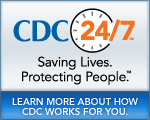MMWR – Morbidity and Mortality Weekly Report
MMWR News Synopsis for June 16, 2011
- Physical Activity Levels Among High School Students — United States, 2010
- Beverage Consumption Among High School Students — United States, 2010
- Place of Influenza Vaccination Among Adults — United States, 2010a€“11 Influenza Season
There is no MMWR telebriefing scheduled for June 16, 2011.
1. Physical Activity Levels Among High School Students — United States, 2010
CDC Division of News and Electronic Media
(404) 639-3286
Data from the 2010 National Youth Physical Activity and Nutrition Survey show that not enough high school students (one out of 10) in grades 9-12 are meeting the Healthy People 2020 physical activity objectives. Youth need at least one hour of physical activity every day and at least 3 days of muscle-strengthening activity per week. Of U.S. high school students, 15.3 percent met the aerobic activity objective, 51 percent met the muscle-strengthening activity objective, and 12.2 percent met the objective for both aerobic and muscle-strengthening activities. Additionally, fewer female students, students in upper grades, and students with obesity meet recommended levels of physical activity. Multi-sectoral approaches involving schools, communities, and healthcare may be needed to increase both aerobic and muscle-strengthening activities among U.S. high school students, with a particular focus on female students, students in upper grades, and students with obesity. For example, evidence-based strategies such as enhancing school-based physical education classes or enhancing access to places for physical activity combined with informational outreach activities about their location and availability can be implemented.
2. Beverage Consumption Among High School Students — United States, 2010
CDC Division of News and Electronic Media
(404) 639-3286
Daily consumption of regular soda or pop, sports drinks, and other sugar-sweetened beverages is highly prevalent among U.S. youth, and especially so among male and black students. These results are from the 2010 National Youth Physical Activity and Nutrition Study (NYPANS)—a school-based survey that collected information on physical activity and dietary behaviors. Sugar-sweetened beverages (e.g., regular soda or pop, sports drinks) are the largest source of added sugars in the diet of U.S. youth. Regularly consuming these beverages increases the intake of calories—a potentially contributing factor to obesity among youth nationwide. Encourage youth to drink more water, low-fat or fat-free milk, and limited quantities of 100 percent fruit juice. Healthy options should be available at home, school, and other youth-serving institutions.
3. Place of Influenza Vaccination Among Adults — United States, 2010a€“11 Influenza Season
CDC Division of News and Electronic Media
(404) 639-3286
The single most common place of influenza vaccination was the doctor's office during the 2010-11 influenza season, while an increasing proportion of influenza vaccinations took place in stores (e.g., a supermarket or drug store). This report estimates that the proportion of adults vaccinated in a doctor's office was 40 percent during the 2010-2011 influenza season. The proportion of adults vaccinated in stores (e.g., a supermarket or drug store) during the 2010-2011 season was 18 percent, an increase of at least 10 percentage points compared to the 1998-1999 and 2006-2007 influenza seasons. Offering influenza vaccination in a variety of settings in the United States is important as the vaccine is recommended for everyone 6 months of age and older.
- Historical Document: June 16, 2011
- Content source: Office of the Associate Director for Communication, Division of News and Electronic Media
- Notice: Linking to a non-federal site does not constitute an endorsement by HHS, CDC or any of its employees of the sponsors or the information and products presented on the site.
View Press Releases in
Get e-mail updates
To receive e-mail updates about this page, enter your
e-mail address:
Contact Us:
- Centers for Disease Control and Prevention
1600 Clifton Rd
Atlanta, GA 30333 - 800-CDC-INFO
(800-232-4636)
TTY: (888) 232-6348 - Contact CDC-INFO


